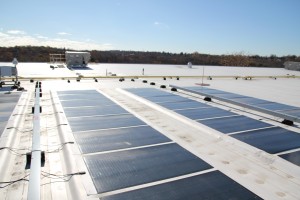Study finds benefits for all ratepayers and greater reduction in greenhouse gases
By Nancy Averett, Boston University
Hoping to reduce their greenhouse emissions, Kelley Hippler and her husband, Tom, installed solar panels on the roof of their Colonial-style home in suburban Sharon in summer 2015. “We had, like a lot of folks, become more aware of global warming and we wanted to look into forms of sustainable energy,” Kelley says.
The couple took advantage of a federal tax credit that lowered the cost of installing their system from $45,000 to $31,500. A state tax credit saved them another $1,000. The solar panels, also known as photovoltaics (PV) systems, have cut the electric bill for their 3,500-square-foot home from an average of $200 a month to basically zero, says Kelley. With the exception of the coldest winter months, they also send enough power back to their electric company most months to earn a small credit on top of the $200 savings. The couple has two meters, one showing how much electricity they draw from their utility company and one showing how much electricity they send back to it. Between September 2015 and April 2016, Kelley says, they earned $100 in credits.
 It’s not surprising that the Hipplers are saving a considerable amount of money with their solar panels. What is remarkable is that, as revealed in a new study by Robert Kaufmann, a professor of earth and environment at Boston University’s College of Arts & Sciences, their solar panels, along with those of about 40,000 other Massachusetts households and community groups, are reducing electricity prices for all of the approximately three million electricity ratepayers in the state, even those with no solar panels.
It’s not surprising that the Hipplers are saving a considerable amount of money with their solar panels. What is remarkable is that, as revealed in a new study by Robert Kaufmann, a professor of earth and environment at Boston University’s College of Arts & Sciences, their solar panels, along with those of about 40,000 other Massachusetts households and community groups, are reducing electricity prices for all of the approximately three million electricity ratepayers in the state, even those with no solar panels.
“Until now, people have focused on how much was being saved by those who owned PV,” says Kaufmann. “What this analysis quantified was that it actually generates savings for everybody.”
Kaufmann’s study, which was co-authored by Devina Vaid, who helped with the research while she was an undergraduate at Vassar College, was published in the June 2016 edition of Energy Policy. It looked at the ways that electricity prices and consumption, power plant efficiency, and PV capacity utilization are related to one another on an hourly basis. “We’re the first ones to really calculate system-wide savings on an hourly basis,” Kaufmann says. He notes in his paper that using an hourly average for electricity prices, rather than a daily average—as many past studies have done—is a more accurate way to quantify how PV systems affect electricity prices, because such prices fluctuate greatly throughout the day.





